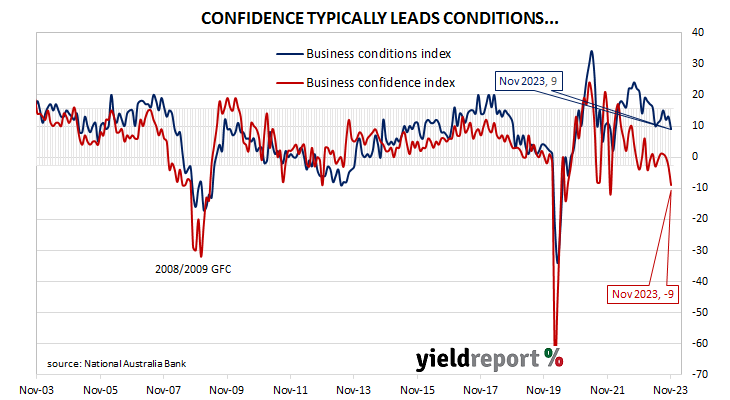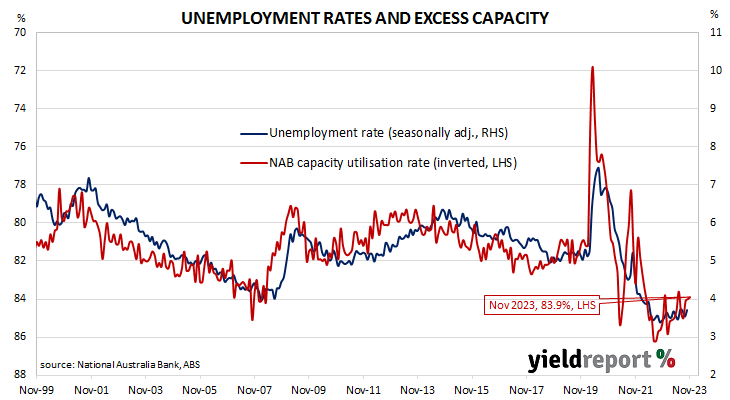Summary: Business conditions deteriorate in November; business pessimism deepens, well below average; conditions, confidence appear to be softening further; ACGB yields decline a little; rate-rise expectations unchanged; Westpac: business confidence has crumbled; capacity utilisation rate declines, still at elevated level.
NAB’s business survey indicated Australian business conditions were robust in the first half of 2018, with a cyclical-peak reached in April of that year. Readings from NAB’s index then began to slip and forecasts of a slowdown in the domestic economy began to emerge in the first half of 2019 as the index trended lower. It hit a nadir in April 2020 as pandemic restrictions were introduced but then improved markedly over the next twelve months and has subsequently remained at robust levels.
According to NAB’s latest monthly business survey of around 500 firms conducted in last week of November, business conditions have deteriorated somewhat, albeit to a level which about average. NAB’s conditions index registered 9 points, down 4 points from October’s reading.
Business confidence deteriorated for a third consecutive month. NAB’s confidence index fell from October’s revised reading of -3 points to -9 points, well below the long-term average. Typically, NAB’s confidence index leads the conditions index by one month, although some divergences have appeared from time to time.
“Both confidence and conditions declined in the month and, after a period of relative stability through mid-2023, appear to be softening further,” said NAB Chief Economist Alan Oster. “Outside of the pandemic period, business confidence is now its weakest since around 2012, when conditions were significantly weaker and growth in advanced economies was slowing.”
The report was released on the same day as the latest Westpac-Melbourne Institute consumer sentiment survey and Commonwealth Government bond yields generally declined a little. By the close of business, the 3-year ACGB yield had slipped 1bp to 3.95%, the 10-year yield lost 2bps to 4.33% while the 20-year yield finished 1bp higher at 4.64%.
In the cash futures market, expectations regarding rate cuts remained essentially unchanged. At the end of the day, contracts implied the cash rate would remain close to the current rate of 4.32% and average 4.305% in January and 4.34% in February. May contracts implied a 4.29% average cash rate, as did August contracts, while November contracts implied 4.08%, 24bps less than the current rate.
“In another sobering update on the Australian economy, it is apparent that business confidence has crumbled at year end,” said Westpac senior economist Andrew Hanlan. “The economy has buckled in the face of the sharply higher interest rates to tame inflation. These developments point to a looming business investment downturn and an easing of inflation pressures.”
NAB’s measure of national capacity utilisation slipped from October’s reading of 84.0% to 83.9%, a level which is still elevated from a historical perspective. All eight sectors of the economy were reported to be operating at or above their respective long-run averages.
Capacity utilisation is generally accepted as an indicator of future investment expenditure and it also has a strong inverse relationship with Australia’s unemployment rate.



